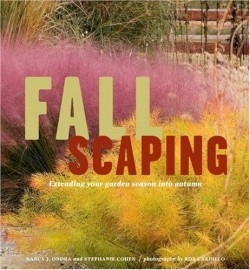Fallscaping
Extending Your Garden Season Into Autumn
“Fall has so much to offer: not just an abundance of beautiful blooms, but a rainbow of foliage colors, flashy fruits and berries, and showy seedheads, too—far more features than spring and summer gardens typically include,” the authors write.
People think of fall as a season for gardeners to reflect on what worked and what failed, but Fallscaping promises to paint the reader’s autumn garden with orange Cannas “Pretoria,” purple coneflowers, maroon foliage from the “Hopi Red Dye” Amaranth, and the hopeful yellows of late-blooming sunflowers.
Authors Nancy Ondra and Stephanie Cohen both hale from Pennsylvania and previously produced The Perennial Gardener’s Design Primer. Ondra ran a rare plant nursery and authored seven books on plants and gardening including Taylor’s Guide to Roses and Taylor’s Weekend Gardening Guide to Soil and Composting. Cohen has received awards from the Pennsylvania Horticultural Society. Hundreds of dramatic photos by Rob Cardillo, who collaborated on several horticultural books, will help identify the plants to enhance a garden’s late-season profile.
The first section of the book is like a brainstorming session. Here the authors introduce flowers, bulbs, grasses, shrubs, berry bushes, and trees that will add color and shape in the fall months, when much vegetation tends to look exhausted. They even have ideas for the most settled grounds. This book can help move gardeners well beyond a few pots of mums and asters.
Scattered throughout the book are thirty-eight practical tips called “Fall Techniques.” They include subjects like deadheading, staking, fall transplanting, dividing, and quick fixes. The authors describe seed gathering: “Some seeds, such as those of morning glories (Ipomoea), and hollyhocks (Alcea)… ripen within an outer covering, called a seedpod. If the pods are fully brown but haven’t opened yet, snip them off into an envelope.”
In addition to these tips, the authors have included a section on partnering plants with an eye toward color, height, sustainability, texture, and mood. Ten eye-catching beds are fully illustrated and each plant is described including Latin and common names, the plant’s light and water preferences, and helpful alternatives if a particular specimen can’t be located. For instance, to create an interesting foundation border, the authors advise readers to use compact shrubs like “Sixteen Candles” Summersweet, which turns brilliant yellow in the fall, combined with a low-growing perennial like Leadwort that produces blue flowers in late summer and whose foliage transforms from green to deep red. Included are shopping lists and placement maps. The thinking is done—all readers have to do is the work.
A short garden primer ensures that this book will come in handy for both novices planning their first garden and seasoned growers who think they know it all. Numerous surprises wait to tantalize the dreamer in the backyard and move them beyond landscaping into Fallscaping.
Disclosure: This article is not an endorsement, but a review. The publisher of this book provided free copies of the book to have their book reviewed by a professional reviewer. No fee was paid by the publisher for this review. Foreword Reviews only recommends books that we love. Foreword Magazine, Inc. is disclosing this in accordance with the Federal Trade Commission’s 16 CFR, Part 255.

